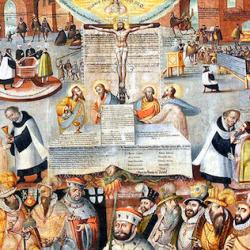In one of the essays in Word and Church, John Webster acknowledges that there is a danger of “spiritualizing” the church when the “asymmetry of divine and human action” is emphasized.
He thinks the claim that Protestantism is pure subjectivism is a “caricature,” but the charge “identifies a potentially disruptive element in the dogmatics we have just outlined. Can a society which is in its essence ‘invisible’ ever be really human – that is, historical, material, bodily?” What must be stressed is that “the concept of the invisibility of the church is a standing denial of any easy identification of divine and human work” (197).
Necessary as this “gesture” is, it can’t be allowed to take over the whole of ecclesiology: “when this necessary gesture takes over, and is allowed to become the only constitutive moment for ecclesiology, other problems quickly emerge, and a picture of the church is promoted in which the human Christian community is unstable, liminal, and so incapable of sustaining a coherent historical and social trajectory” (197). It’s a limiting concept; a bow of humility.
What must also be stressed is the ordering power of the Spirit: “The ‘spirituality’ of the church and its ‘visibility’ or ‘order’ are not quite different entities, the latter, perhaps, clothing the former but bearing no essential or intrinsic relation to it. Order does not constitute the church apart from the vivifying and sanctifying grace of the Spirit; but the life and holiness which the Spirit bestows are ordered because human, social and continuous. The danger of collapsing Spirit into structure ought not to frighten us into the equal danger of a purely punctiliar or actualistic ecclesiology. Church order is the social shape of the converting power and activity of Christ present as Spirit” (197-8).















